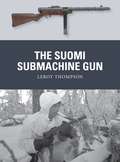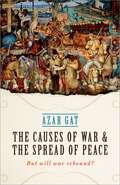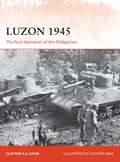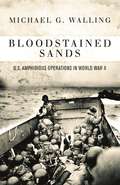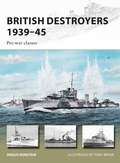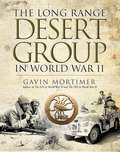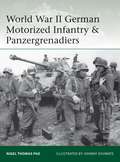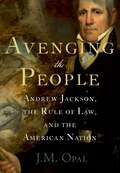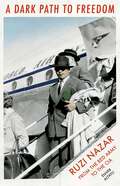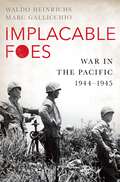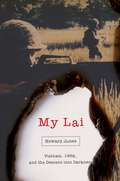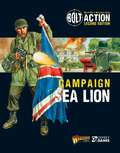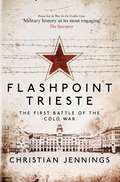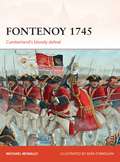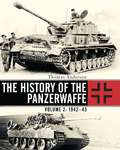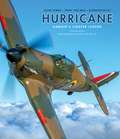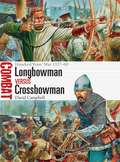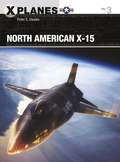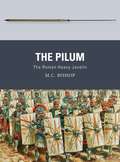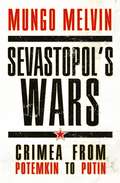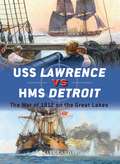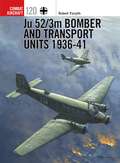- Table View
- List View
The Suomi Submachine Gun (Weapon)
by Adam Hook Leroy Thompson Alan GillilandEntering service in 1931, the 9x19mm Suomi KP/-31 submachine gun saw extensive combat with Finnish troops during their fight against Soviet forces in 1939–44. It was also manufactured under licence in Switzerland, Denmark and Sweden, and remained in Finnish service until the 1980s, an indication of its durability.Rugged and accurate, the Suomi was a favourite with Finnish ski troops who would strike from ambush, cutting down Soviet troops, then skiing away into the woods. Initially used by the Finns as a light machine gun at infantry squad level, it eventually became a dedicated submachine gun, and since it had been designed to be more accurate than the typical SMG, it was often even used as a sniping weapon, or to supplement longer-ranged rifles such as the Mosin-Nagant. Featuring first-hand accounts and specially commissioned colour artwork, this is the story of one of World War II's most distinctive and respected infantry weapons.
The Causes of War and the Spread of Peace: But Will War Rebound?
by Azar GatAzar Gat sets out to resolve one of the age-old questions of human existence: why people fight and can they stop. Spanning warfare from prehistory to the 21st century, the book shows that, neither an irresistible drive nor a cultural invention, deadly violence and warfare have figured prominently in our behavioural toolkit since the dawn of our species. People have always alternated between cooperation, peaceful competition, and violence to attain evolution-shaped human desires. A marked shift in the balance between these options has occurred since the onset of the industrial age. Rather than modern war becoming more costly (it hasn't), it is peace that has become more rewarding. Scrutinizing existing theories concerning the decline of war - such as the 'democratic peace' and 'capitalist peace' - Gat shows that they in fact partake of a broader Modernization Peace that has been growing since 1815. By now, war has disappeared within the world's most developed areas. Finally, Gat explains why the Modernization Peace has been disrupted in the past, as during the two World Wars, and how challenges to it may still arise. They include claimants to alternative modernity - such as China and Russia - anti-modernists, and failed modernizers that may spawn terrorism, potentially unconventional. While the world has become more peaceful than ever before, there is still much to worry about in terms of security and no place for complacency.
Luzon 1945: The final liberation of the Philippines (Campaign #306)
by Clayton Chun Giuseppe RavaDriven from the Philippines in 1942, General Douglas MacArthur returned three years later to force the Japanese off of its main island of Luzon. Containing the capital of Manila, vital natural resources as well as thousands of Allied prisoners of war, the triumph at Luzon would be a vital step on the road to victory as the Americans continued to island-hop their way towards the Japanese home islands. This new study details one of the hardest-fought campaigns of the Pacific War with Japanese fatalities alone on Luzon topping 200,000. Emphasizing the differences in Japanese and American strategy, and detailing the combat operations of the campaign, this volume tells the story of how MacArthur kept his promise to return and liberate the Philippines.
Bloodstained Sands: U.S. Amphibious Operations in World War II
by Michael G. WallingFor the men who served in America's Amphibious Forces during World War II, the conflict was an unceasing series of D-Days. They were responsible for putting men ashore in more than 200 landings throughout the conflict, most against well-entrenched enemy positions. Bloodstained Sands: US Amphibious Operations in World War II tells the story of these forgotten men for the first time, tracing their operational history from Guadalcanal to Casablanca, Sicily, Normandy, Iwo Jima and finally Okinawa. The men's stories are told in their own voices, with fascinating accounts from Underwater Demolition Teams, Attack Transport crews and many other unsung heroes of World War II.First-hand interviews, entries from personal diaries and Action Reports create a unique history, perfectly complemented by historic illustrations and detailed maps. These are timeless tales of determination, sacrifice, and triumph of the human spirit - tales of US Amphibious Forces that for too long have gone forgotten and untold.
British Destroyers 1939–45: Pre-war classes (New Vanguard #246)
by Angus KonstamThe Royal Navy entered World War II with a large but eclectic fleet of destroyers. Some of these were veterans of World War I, fit only for escort duties. Most though, had been built during the inter-war period, and were regarded as both reliable and versatile. Danger though lurked across the seas as new destroyers being built in Germany, Italy and Japan were larger and better armoured. So, until the new, larger Tribal-class destroyers could enter service, these vessels would have to hold the line. Used mainly to hunt submarines, protect convoys from aerial attack, and take out other destroyers, these ships served across the globe during the war. This fully illustrated study is the first in a two-part series on the real workhorses of the wartime Royal Navy, focusing on how these ageing ships took on the formidable navies of the Axis powers.
Lancaster
by Bloomsbury PublishingThe star of the famous 'Dambusters' raid, the Avro Lancaster also formed the backbone of the RAF's Bomber Command during the large-scale night bombing campaign against occupied Europe during World War II. Unable to hit back on the ground, with the Lancaster, Britain could take the fight to Germany. This complete illustrated guide to one of Britain's most iconic aircraft explores its history, strengths, weaknesses and combat performance in the war that would make it legendary. Featuring stunning artwork and contemporary photographs, this book reveals how the Lancaster became the RAF's most successful heavy bomber of the war, and a symbol of British resistance and air power.
The Long Range Desert Group in World War II
by Gavin MortimerFormed in June 1940 for the purpose of gathering intelligence behind enemy lines, the Long Range Desert Group (LRDG) played a secretive but vital role in North Africa during World War II. Highly trained in mechanized reconnaissance and specializing in desert operations, the unit provided support to the Special Air Service (SAS) in missions across the vast and treacherous terrain of the Western Desert. In this highly illustrated history of the LRDG, Gavin Mortimer reveals the origins and dramatic operations of Britain's first ever special forces unit.
World War II German Motorized Infantry & Panzergrenadiers (Elite)
by Johnny Shumate Nigel ThomasIn World War II Germany's doctrine of mobile warfare dominated the battlefield. By trial and error, the Germans were the first to correctly combine the strength in tanks and in mobile infantry and artillery. This integration of mobile units, equipment and tactics underpinned Germany's successes in the first half of the war. As the war dragged on, the Allies sought to copy German tactics but German armies remained supreme in this type of warfare until their losses had seriously degraded their capabilities. This study traces the development of the different types of unit that came together in the Panzergrenadier branch from the inter-war years through World War II. Using colour plates to display the changes in uniform, equipment and insignia in all theatres of operations throughout the conflict, this is a complete account of Hitler's elite armoured infantry.
Dancing in the English style: Consumption, Americanisation and national identity in Britain, 1918–50 (Studies in Popular Culture)
by Allison AbraThis book illuminates the history of popular dance, one of the most influential and widespread leisure practices in early twentieth-century Britain. It focuses in particular on the relationship between dancing and national identity construction, in a period when Britain participated in increasingly global markets of popular cultural production, consumption, and exchange.
Avenging the People: Andrew Jackson, the Rule of Law, and the American Nation
by J.M. OpalMost Americans know Andrew Jackson as a frontier rebel against political and diplomatic norms, a "populist" champion of ordinary people against the elitist legacy of the Founding Fathers. Many date the onset of American democracy to his 1829 inauguration. Despite his reverence for the "sovereign people," however, Jackson spent much of his career limiting that sovereignty, imposing new and often unpopular legal regimes over American lands and markets. He made his name as a lawyer, businessman, and official along the Carolina and Tennessee frontiers, at times ejecting white squatters from native lands and returning slaves to native planters in the name of federal authority and international law. On the other hand, he waged total war on the Cherokees and Creeks who terrorized western settlements and raged at the national statesmen who refused to "avenge the blood" of innocent colonists. During the long war in the south and west from 1811 to 1818 he brushed aside legal restraints on holy genocide and mass retaliation, presenting himself as the only man who would protect white families from hostile empires, "heathen" warriors, and rebellious slaves. He became a towering hero to those who saw the United States as uniquely lawful and victimized. And he used that legend to beat back a range of political, economic, and moral alternatives for the republican future. Drawing from new evidence about Jackson and the southern frontiers, Avenging the People boldly reinterprets the grim and principled man whose version of American nationhood continues to shape American democracy.
A Dark Path to Freedom: Rusi Nazar from the Red Army to the CIA
by Enver AltayliBorn in Margilan, Central Asia on the eve of the Russian Revolution of 1917, Ruzi Nazar had one of the most exciting lives of the twentieth century. Charming, intellectually brilliant and passionately committed to the liberation of Central Asia from Russian rule, his life was a series of adventures and narrow escapes. He was successively a Soviet student, a Red Army officer, an officer in the German Turkestan Legion during World War II, a fugitive living in postwar Germany's underworld, and finally an immigrant to the United States who rose high in the CIA. Here he mixed with the powerful and famous, represented the US as a diplomat in Ankara and Bonn, and became an undercover agent in Iran after the hostage crisis of 1979-81. Nazar's foresight was formidable. He predicted that communism would collapse from within, briefing Reagan on the weakness of the Soviet system before the Reagan-Gorbachev talks. A Muslim who rejected Islamism, his warnings to the US government about the dangers of Islamic radicalism fell on deaf ears. This remarkable biography casts unique light on the lives of people caught up in the turmoil of the Soviet Union, World War II, the Cold War, and the struggle of nationalities deprived of their freedom by communism to regain independence.
Implacable Foes: War in the Pacific, 1944-1945
by Waldo Heinrichs Marc GallicchioOn May 8, 1945, Victory in Europe Day-shortened to "V.E. Day"-brought with it the demise of Nazi Germany. But for the Allies, the war was only half-won. Exhausted but exuberant American soldiers, ready to return home, were sent to join the fighting in the Pacific, which by the spring and summer of 1945 had turned into a gruelling campaign of bloody attrition against an enemy determined to fight to the last man. Germany had surrendered unconditionally. The Japanese would clearly make the conditions of victory extraordinarily high. In the United States, Americans clamored for their troops to come home and for a return to a peacetime economy. Politics intruded upon military policy while a new and untested president struggled to strategize among a military command that was often mired in rivalry. The task of defeating the Japanese seemed nearly unsurmountable, even while plans to invade the home islands were being drawn. Army Chief of Staff General George C. Marshall warned of the toll that "the agony of enduring battle" would likely take. General Douglas MacArthur clashed with Marshall and Admiral Nimitz over the most effective way to defeat the increasingly resilient Japanese combatants. In the midst of this division, the Army began a program of partial demobilization of troops in Europe, which depleted units at a time when they most needed experienced soldiers. In this context of military emergency, the fearsome projections of the human cost of invading the Japanese homeland, and weakening social and political will, victory was salvaged by means of a horrific new weapon. As one Army staff officer admitted, "The capitulation of Hirohito saved our necks." In Implacable Foes, award-winning historians Waldo Heinrichs (a veteran of both theatres of war in World War II) and Marc Gallicchio bring to life the final year of World War Two in the Pacific right up to the dropping of the atomic bombs over Hiroshima and Nagasaki, evoking not only Japanese policies of desperate defense, but the sometimes rancorous debates on the home front. They deliver a gripping and provocative narrative that challenges the decision-making of U.S. leaders and delineates the consequences of prioritizing the European front. The result is a masterly work of military history that evaluates the nearly insurmountable trials associated with waging global war and the sacrifices necessary to succeed.
My Lai: Vietnam, 1968, and the Descent into Darkness (Pivotal Moments in American History)
by Howard JonesOn the early morning of March 16, 1968, American soldiers from three platoons of Charlie Company (1st Battalion, 20th Infantry Regiment, 11th Brigade, 23rd Infantry Division), entered a group of hamlets located in the Son Tinh district of South Vietnam, located near the Demilitarized Zone and known as "Pinkville" because of the high level of Vietcong infiltration. The soldiers, many still teenagers who had been in the country for three months, were on a "search and destroy" mission. The Tet Offensive had occurred only weeks earlier and in the same area and had made them jittery; so had mounting losses from booby traps and a seemingly invisible enemy. Three hours after the GIs entered the hamlets, more than five hundred unarmed villagers lay dead, killed in cold blood. The atrocity took its name from one of the hamlets, known by the Americans as My Lai 4. Military authorities attempted to suppress the news of My Lai, until some who had been there, in particular a helicopter pilot named Hugh Thompson and a door gunner named Lawrence Colburn, spoke up about what they had seen. The official line was that the villagers had been killed by artillery and gunship fire rather than by small arms. That line soon began to fray. Lieutenant William Calley, one of the platoon leaders, admitted to shooting the villagers but insisted that he had acted upon orders. An exposé of the massacre and cover-up by journalist Seymour Hersh, followed by graphic photographs, incited international outrage, and Congressional and U.S. Army inquiries began. Calley and nearly thirty other officers were charged with war crimes, though Calley alone was convicted and would serve three and a half years under house arrest before being paroled in 1974. My Lai polarized American sentiment. Many saw Calley as a scapegoat, the victim of a doomed strategy in an unwinnable war. Others saw a war criminal. President Nixon was poised to offer a presidential pardon. The atrocity intensified opposition to the war, devastating any pretense of American moral superiority. Its effect on military morale and policy was profound and enduring. The Army implemented reforms and began enforcing adherence to the Hague and Geneva conventions. Before launching an offensive during Desert Storm in 1991, one general warned his brigade commanders, "No My Lais in this division--do you hear me?" Compelling, comprehensive, and haunting, based on both exhaustive archival research and extensive interviews, Howard Jones's My Lai will stand as the definitive book on one of the most devastating events in American military history.
Rebooting Clausewitz: 'On War' in the Twenty-First Century
by Christopher CokerRebooting Clausewitz offers an entirely new take on the work of history's greatest theorist of war. Written for an undergraduate readership that often struggles with Clausewitz's master work On War--a book that is often considered too philosophical and impenetrably dense--it seeks to unpack some of Clausewitz's key insights on theory and strategy. In three fictional interludes Clausewitz attends a seminar at West Point; debates the War on Terror at a Washington think tank; and visits a Robotics Institute in Santa Fe where he discusses how scientists are reshaping the future of war. Three separate essays situate Clausewitz in the context of his times, discuss his understanding of the culture of war, and the extent to which two other giants--Thucydides and Sun Tzu--complement his work. Some years ago the philosopher W.B. Gallie argued that Clausewitz needed to be 'saved from the Clausewitzians'. Clausewitz doesn't need saving and his commentators have contributed a great deal to our understanding of On War's seminal status as a text. But too often they tend to conduct a conversation between themselves. This book is an attempt to let a wider audience into the conversation.
Bolt Action: Sea Lion (Bolt Action)
by Warlord GamesThe year is 1940, and the German invasion of Britain has begun. With this new campaign book for Bolt Action, players can fight the battles of World War II's greatest 'what if' scenario. Defend the cliffs of Dover and the beaches of Kent from wave after wave of German landing craft. Parachute into the Home Counties in a surgical strike to capture Winston Churchill. Rally the Home Guard in a last, desperate attempt to keep England free of the Nazi invaders! Containing new rules, scenarios, and unit types covering all of the unique features of this alternate history campaign, it offers a chance for all Bolt Action players to truly rewrite the history of World War II.
Flashpoint Trieste: The First Battle of the Cold War
by Christian JenningsFlashpoint Trieste is the story of one year in one city as the Cold War begins. The Western Allies captured the Adriatic port city before the Russians could reach it, but having survived the war, everybody is now desperate to make it through the liberation. Life is fast and violent, as former warring parties find common cause against the Soviet Union and the borders of the new Europe are being hammered out. Against this deadly backdrop of espionage, escape and revenge, the British and Americans are locked into the opening stages of the Cold War on the beautiful shores of the Adriatic, opposing the Russians and Yugoslavs. Now published in paperback, this is the story of the first turbulent post-war year of lethal cat-and-mouse in south-eastern Europe, told through the stories of twelve men and women from seven different countries thrown together on a strategically vital frontier between East and West.
Fontenoy 1745: Cumberland's bloody defeat (Campaign #307)
by Michael McNally Seán Ó’BrógáinA disputed succession to the Austrian throne led to general war between the leading powers of Europe in 1740, with France, Spain and Prussia on one side, and Britain, Habsburg Austria and the Dutch Republic on the other. While fighting occurred across the globe, the bloodiest battles were fought on the European continent, with none more costly than the battle of Fontenoy in 1745.Fearing an encirclement of France by a resurgent Habsburg-controlled Austria, the French commander Marshall Saxe planned to overrun the Austrian Netherlands, thereby dealing a decisive blow against their enemy's ability to wage war. Saxe's army, the cream of the French military, invaded and set up a defensive position at Fontenoy, near Tournai – daring his enemies to knock him off his perch. This title, beautifully illustrated with full colour plates, is an in-depth study of the British Duke of Cumberland's attempt to assault Saxe's position. It focuses on the inability of allied leaders to coordinate their attacks and how Cumberland came within a whisker of achieving a major victory.
The History of the Panzerwaffe: Volume 2: 1942–45
by Thomas AndersonThe final years of World War II saw the legendary Panzerwaffe face its most difficult challenges, with Allied troops landing at Normandy and storming across the continent and the Russians gaining the upper hand on the Eastern Front. As Germany fought fiercely to hold on to the advantages gained in the early years, they relied heavily on the Panzer IV, the Panzer V Panther and the StuG III – the backbone of their infamous armoured divisions – to hold back their advancing opponents. This second volume on the Panzerwaffe offers a comprehensive guide to the final years of Germany's most famous fighting force, covering the further use of the Panzer IV, the role played by the StuG III assault gun and the battlefield debut of the formidable Panther. Explosive combat reports and rare archive photographs help uncover the final years of the Panzers, from their defence against the D-Day landings and the role they played in the Ardennes Offensive to their valiant last stand in Berlin.
Hurricane: Hawker's Fighter Legend
by John Dibbs Tony Holmes Gordon Riley2017 marks the 80th anniversary of the remarkable Hawker Hurricane formally entering service. The RAF's first monoplane fighter, it dragged the Air Force into a position where it could defend Britain in her 'hour of need'. The true workhorse of the RAF, the Hurricane came into its own in the hot summer months of 1940 valiantly defending the skies above Britain. Outnumbering Spitfires three to one, the Hurricane also downed far more enemy aircraft. Without the obvious elegance of the Me 109 or the Spitfire, the Hurricane was nonetheless beloved by its pilots for its ability to simultaneously take a battering and inflict serious damage from its remarkably stable gun platform. This stunning new book reveals the Hurricane in all its glory – from fascinating first-hand accounts from the men who flew her to the truly breathtaking images from John Dibbs of the Hurricanes still in flight today. This lavish, fully illustrated edition is a must-have for all fans of aviation history.
Longbowman vs Crossbowman: Hundred Years’ War 1337–60 (Combat)
by Peter Dennis David CampbellFor centuries, the crossbow had played a key role on the battlefields of continental Europe, with mercenaries from Genoa and Brabant in particular filling the ranks of the French army, yet on the outbreak of the Hundred Years' War they came up against a more powerful foe. To master the English longbow was a labour of years, requiring far greater skill to use than the crossbow, but it was much more flexible and formidable, striking fear into the French and their allies.This study examines three battles – Sluys (1340), Crécy (1346) and Poitiers (1356) – and shows how the use of the longbow allowed England's armies to inflict crushing defeats on numerically superior forces. The longbow changed the shape of war, becoming the defining weapon of the age and wreaking havoc upon the French armies that would face it. Featuring full-colour artwork, this is the engrossing story of the first clashes between the English longbowmen and the crossbowmen of the French king on the bloody battlefields of the Hundred Years' War.
North American X-15 (X-Planes)
by Peter E. DaviesThe revolutionary X-15 remains the fastest manned aircraft ever to fly. Built in the two decades following World War II, it was the most successful of the high-speed X-planes. The only recently broken 'sound barrier' was smashed completely by the X-15, which could hit Mach 6.7 and soar to altitudes above 350,000ft, beyond the edge of space. Several pilots qualified as astronauts by flying above 50 miles altitude in the X-15, including Neil Armstrong, the first man on the Moon. The three X-15s made 199 flights, testing new technologies and techniques which greatly eased America's entry into manned space travel, and made the Apollo missions and Space Shuttle viable propositions. With historical photographs and stunning digital artwork, this is the story of arguably the greatest of the X-Planes.
The Pilum: The Roman Heavy Javelin (Weapon)
by Peter Dennis M. C. BishopA heavy javelin, normally used as a shock weapon immediately before contact, the pilum was designed with a particular speciality: it could penetrate a shield and carry on into the individual behind it. Relying on mass rather than velocity, at short range a volley of pila had much the same effect on a charging enemy as musketry would in later periods. The design was not uniform, with a wide diversity of types throughout the developmental history of the weapon, but for more than four centuries it remained a vital part of the arsenal of weapons at the disposal of the Roman legionary. Drawing upon recent major finds in the Iberian Peninsula and the Balkans, as well as written records and rigorous scientific analysis, this enthralling study lifts the veil on the evolving nature of the pilum, the Roman heavy javelin that helped to conquer the known world.
Sevastopol’s Wars: Crimea from Potemkin to Putin
by Mungo Melvin CB OBEFounded by Catherine the Great, the maritime city of Sevastopol has been fought over for centuries. Crucial battles of the Crimean War were fought on the hills surrounding the city, and the memory of this stalwart defence inspired those who fruitlessly battled the Germans during World War II. Twice the city has faced complete obliteration yet twice it has risen, phoenix-like, from the ashes.In this groundbreaking volume, award-winning author Mungo Melvin explores how Sevastopol became the crucible of conflict over three major engagements – the Crimean War, the Russian Civil War and World War II – witnessing the death and destruction of countless armies yet creating the indomitable 'spirit of Sevastopol'. By weaving together first-hand interviews, detailed operational reports and battle analysis, Melvin creates a rich tapestry of history.
USS Lawrence vs HMS Detroit: The War of 1812 on the Great Lakes (Duel)
by Paul Wright Mark LardasThe most critical naval fighting during the War of 1812 took place, not on the high seas, but on the inland lakes of North America: the Great Lakes and Lake Champlain. Carrying between 12 and 22 cannon, the British and American sloops-of-war were ship-rigged, brig-rigged or schooner-rigged vessels. Lakes actions often involved two ships facing each other broadside to broadside, the best example of which was the battle of Lake Erie in 1813 where HMS Detroit led a Royal Navy squadron against the USS Lawrence-led US Navy.Featuring full-colour artwork, this lively study investigates the prolonged struggle between British and US sloops-of-war, highlighting the differences between the war on the lakes and the war on the oceans during the Age of Fighting Sail. It reveals the circumstances under which these ships were built, how they were armed, and the human story behind their construction and use in battle.
Ju 52/3m Bomber and Transport Units 1936-41 (Combat Aircraft)
by Jim Laurier Robert Forsyth Mark PostlethwaiteThe all-metal Junkers Ju 52/3m enjoyed a solid – indeed, revered – reputation amongst its crews and the troops and paratroopers who used and depended on it. For more than ten years, it saw service as a successful military transport, with its distinctive, three-engined design and corrugated metal construction becoming instantly recognisable. It was a mainstay in the Luftwaffe's inventory, first seeing service in the 1930s in bombing and transport operations in the Spanish Civil War, and subsequently during the German invasion of Poland. It then served on every front on which the Luftwaffe was deployed until May 1945. The Junkers served as a stalwart transport, confronting both freezing temperatures and ice, and heat and dust, lifting men, animals, food and supplies vital for German military operations. This, the first of two books on the Ju 52/3m, details its service as a bomber in Spain and in South America, followed by its pivotal role in early war operations during the invasions of Poland and France, the airborne invasion of Crete and the early stages of Operation Barbarossa.
